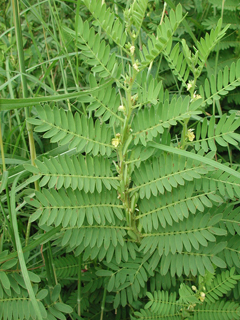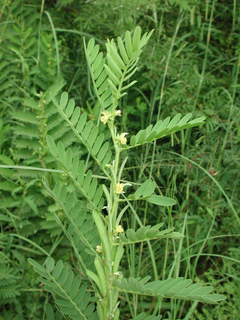 |
|
Stefan Dressler; African plants - A Photo Guide |
 |
| Stefan Dressler; African plants - A Photo Guide |
Translate this page:
Summary
Chamaecrista nigricans is an erect , tropical, woody plant up to 150 cm tall found in Africa. It is usually harvested from the wild for medicinal purposes. Mature leaves of C nigricans are bitter and added to food as an appetizer. Though used as pesticide, the leaves have medicinal purposes as well and used in the treatment of fever, malaria, cough, stomach pain, ulcers, diarrhoea, and worms. Infusion or decoction of leaves is applied on wounds and other skin conditions. The leaves can also be dried and made into powder and later on used as a storage protectant for pulses.
Physical Characteristics

 Chamaecrista nigricans is a PERENNIAL growing to 1.5 m (5ft) by 1.5 m (5ft) at a fast rate.
Chamaecrista nigricans is a PERENNIAL growing to 1.5 m (5ft) by 1.5 m (5ft) at a fast rate.
See above for USDA hardiness. It is hardy to UK zone 10.
It can fix Nitrogen.
Suitable for: light (sandy), medium (loamy) and heavy (clay) soils, prefers well-drained soil and can grow in heavy clay soil. Suitable pH: mildly acid, neutral and basic (mildly alkaline) soils. It cannot grow in the shade. It prefers moist soil.
UK Hardiness Map
US Hardiness Map
Synonyms
Cassia nigricans Vahl
Plant Habitats
Edible Uses
Edible Parts: Leaves
Edible Uses: Condiment
The bitter mature leaves are added to food as an appetizer[ 299 ]. The leaves are used for flavouring in sauces and other dishes.
References More on Edible Uses
Medicinal Uses
Plants For A Future can not take any responsibility for any adverse effects from the use of plants. Always seek advice from a professional before using a plant medicinally.
Analgesic Anthelmintic Antibacterial Antidiarrhoeal Antiinflammatory Antiseptic Antitussive Astringent
Cholera Febrifuge Malaria Parasiticide Purgative Skin Stings
Vermifuge
The leaves are antiseptic, astringent, pesticide and vermifuge[ 299 ]. They are used in the treatment of a wide range of conditions including fevers and malaria; venereal diseases; coughs; stomach-ache, peptic ulcers, diarrhoea and worms[ 299 ]. An infusion of the aerial parts is taken as an anti-menstruation agent[ 299 ]. Externally, an infusion or decoction of the leaves is applied to various skin conditions including insect stings, itching skin, wounds and abscesses[ 299 ]. They are pounded in water and applied to ticks on humans and horses; and, mixed with palm oil, are rubbed on the head to kill lice[ 299 ]. An infusion of the aerial parts is added to a bath to treat haemorrhoids[ 299 ]. The root is anthelmintic, astringent, oxytocic and purgative[ 299 ]. Pounded with water, it is used as a treatment against diarrhoea, whilst an infusion or decoction is used to remove internal parasites and stimulate uterine contractions to remove a retained placenta and to promote labour[ 299 ]. The leaves contain the anthraquinone emodin[ 299 ]. Methanolic extracts have shown analgesic and anti-inflammatory effects. They have also shown a protective action against ulcers, this may be via histaminergic receptor inhibition[ 299 ]. The extract also has a dose-dependent antidiarrhoeal activity[ 299 ]. The extract has also shown contraceptive activity through oestrogenic and anti-implantation activities[ 299 ]. Ethanolic plant extracts have shown antibacterial activity against Shigella dysenteriae, Staphylococcus aureus, Staphylococcus faecalis, and Vibrio cholerae[ 299 ]. Tests with plant extracts have shown significant action against Herpes simplex virus type 1 in vitro[ 299 ].
References More on Medicinal Uses
The Bookshop: Edible Plant Books
Our Latest books on Perennial Plants For Food Forests and Permaculture Gardens in paperback or digital formats.

Edible Tropical Plants
Food Forest Plants for Hotter Conditions: 250+ Plants For Tropical Food Forests & Permaculture Gardens.
More

Edible Temperate Plants
Plants for Your Food Forest: 500 Plants for Temperate Food Forests & Permaculture Gardens.
More

More Books
PFAF have eight books available in paperback and digital formats. Browse the shop for more information.
Shop Now
Other Uses
Hair Insecticide Parasiticide Repellent
Other uses rating: High (4/5). Other Uses: The dried leaves, leaf powder, ash and extracts have all been used as a protection from insects in the storage of pulses and cereals[ 299 ]. It has been shown that the powdered leaves are effective as a storage protectant for pulses, as they inhibit the hatching of insect larvae. They are not a health threat if removed before consumption[ 299 ].
Special Uses
Nitrogen Fixer
References More on Other Uses
Cultivation details
The plant has a wide distribution in the tropics, being found in a wide range of habitats at elevations up to 1,200 metres. It grows well in areas with a mean annual rainfall in the range 950 - 1,400mm spread over 5 - 6 months, as in the Sudano-Guinean zone of West Africa[ 299 ]. The plant is especially common on heavy lateritic soils[ 299 ]. The plant is a spontaneous weed through much of the tropics and subtropics, and is sometimes found even in Australia[ 299 ]. This species has a symbiotic relationship with certain soil bacteria; these bacteria form nodules on the roots and fix atmospheric nitrogen. Some of this nitrogen is utilized by the growing plant but some can also be used by other plants growing nearby[ 755 ].
References Carbon Farming Information and Carbon Sequestration Information
Temperature Converter
Type a value in the Celsius field to convert the value to Fahrenheit:
Fahrenheit:
The PFAF Bookshop
Plants For A Future have a number of books available in paperback and digital form. Book titles include Edible Plants, Edible Perennials, Edible Trees,Edible Shrubs, Woodland Gardening, and Temperate Food Forest Plants. Our new book is Food Forest Plants For Hotter Conditions (Tropical and Sub-Tropical).
Shop Now
Plant Propagation
Propagation Seed - germinates easily[ 299 ].
Other Names
If available other names are mentioned here
Chamaecrista nigricans. Other Names: Bara-bubel, Bono, Chila-ja-lo, Heb eddbae, Lali-baba, Macarra-bubel, Massacali, Silatalo.
Native Range
TROPICAL ASIA: India AUSTRALASIA: Australia (Northern Territory) AFRICA: Djibouti, Eritrea, Ethiopia, Sudan (Central, Darfur, Eastern, Kordofan), South Sudan (Central Equatoria, Eastern Equatoria, Northern Bahr el Ghazal, Upper Nile, Western Bahr el Ghazal, Western Equatoria), Chad, Kenya, Tanzania, Uganda, Central African Republic, Benin, Burkina Faso, Côte D‘Ivoire, Ghana, Gambia, Guinea-Bissau, Mali, Mauritania, Niger, Nigeria, Senegal, Angola, Zambia
Weed Potential
Right plant wrong place. We are currently updating this section.
Please note that a plant may be invasive in one area but may not in your area so it's worth checking.
The plant is a spontaneous weed through much of the tropics and subtropics, and is sometimes found even in Australia
Conservation Status
IUCN Red List of Threatened Plants Status : This taxon has not yet been assessed.

Growth: S = slow M = medium F = fast. Soil: L = light (sandy) M = medium H = heavy (clay). pH: A = acid N = neutral B = basic (alkaline). Shade: F = full shade S = semi-shade N = no shade. Moisture: D = dry M = Moist We = wet Wa = water.
Now available:
Food Forest Plants for Mediterranean Conditions
350+ Perennial Plants For Mediterranean and Drier Food Forests and Permaculture Gardens.
[Paperback and eBook]
This is the third in Plants For A Future's series of plant guides for food forests tailored to
specific climate zones. Following volumes on temperate and tropical ecosystems, this book focuses
on species suited to Mediterranean conditions—regions with hot, dry summers and cool, wet winters,
often facing the added challenge of climate change.
Read More
Expert comment
Author
(Vahl) Greene
Botanical References
Links / References
For a list of references used on this page please go here
A special thanks to Ken Fern for some of the information used on this page.
Readers comment
| Add a comment |
|
If you have important information about this plant that may help other users please add a comment or link below. Only comments or links that are felt to be directly relevant to a plant will be included. If you think a comment/link or information contained on this page is inaccurate or misleading we would welcome your feedback at [email protected]. If you have questions about a plant please use the Forum on this website as we do not have the resources to answer questions ourselves.
* Please note: the comments by website users are not necessarily those held by PFAF and may give misleading or inaccurate information.
To leave a comment please Register or login here All comments need to be approved so will not appear immediately.
|
Subject : Chamaecrista nigricans
|
|
|
|